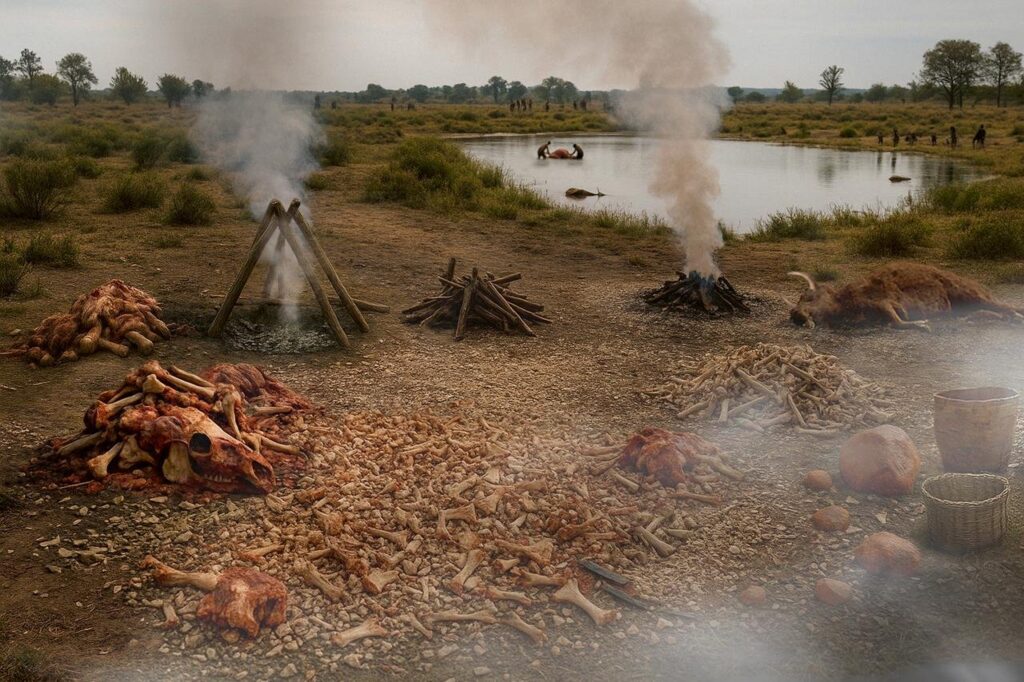
Neanderthals in central Germany, 125,000 years ago, employed a sophisticated method of food preparation by systematically extracting fat from the bones of large animals using water and heat. This discovery, made at the Neumark-Nord 2 archaeological site, suggests that Neanderthals possessed a far more advanced understanding of nutrition, planning, and resource management than previously acknowledged.
The groundbreaking research, published in Science Advances, was conducted by an international team from MONREPOS (Leibniz Centre for Archaeology), Leiden University in the Netherlands, and the State Office for Heritage Management and Archaeology of Saxony-Anhalt. The study reveals that Neanderthals, in addition to the well-documented practice of smashing bones to access marrow, also crushed bones into fragments and boiled them to extract bone grease, a nutrient-rich resource.
Revolutionizing Our Understanding of Neanderthal Diets
Dr. Lutz Kindler, the study’s lead author, emphasized the strategic nature of these activities.
“This was intensive, organized, and strategic,” he noted. “Neanderthals were clearly managing resources with caution—planning hunts, transporting carcasses, and rendering fat in a task-specific area. They understood both the nutritional value of fat and how to access it efficiently.”
At least 172 large mammals, including deer, horses, and aurochs, were butchered at the site. The production of bone grease, which necessitated vast quantities of bone to be efficient, was previously thought to be a practice exclusive to Upper Paleolithic modern humans. This new evidence significantly pushes back the timeline and represents a fundamental shift in our understanding of Neanderthal dietary practices and adaptability.
The Neumark-Nord Complex: A Window into the Past
The Neumark-Nord complex, discovered in the 1980s by archaeologist Dietrich Mania, is a well-preserved interglacial ecosystem. Excavations conducted from 2004 to 2009 uncovered several zones dedicated to various Neanderthal activities: deer hunting and light butchering in one area, straight-tusked elephant processing in another, and fat extraction in a third, specialized zone. Remarkably, cut-marked remains of 76 rhinos and 40 elephants were also found at nearby sites such as Taubach.
Prof. Wil Roebroeks of Leiden University remarked on the site’s significance.
“What makes Neumark-Nord so exceptional is the preservation of an entire landscape, not just a single site,” he said. “We are seeing a range of Neanderthal behaviors within the same landscape.”
Implications for Neanderthal Intelligence and Environmental Impact
The activities of the Neanderthals at Neumark-Nord not only demonstrate their high level of sophistication but also suggest long-term environmental impacts. Prof. Roebroeks warned that their mass hunting of slow-reproducing species likely had significant consequences for the fauna in the region during the Last Interglacial period.
This discovery challenges the stereotype of Neanderthals as brutish cavemen, instead portraying them as capable and intelligent beings who could plan for the future, manage their environment, and maximize nutrition in resource-scarce settings. The “fat factory” at Neumark-Nord reveals a species adept at resource management and environmental adaptation.
Looking Forward: Redefining Prehistoric Human Capabilities
The findings at Neumark-Nord invite a reevaluation of Neanderthal capabilities and their role in human evolution. As researchers continue to uncover more about their complex behaviors, the narrative of Neanderthals is shifting from one of simplicity to one of intricate social structures and advanced survival strategies.
Future research may further illuminate how these practices influenced the evolution of human dietary habits and ecological strategies. As we continue to piece together the story of our ancient relatives, the Neumark-Nord site stands as a testament to the ingenuity and adaptability of Neanderthals, offering valuable insights into the prehistoric world.







